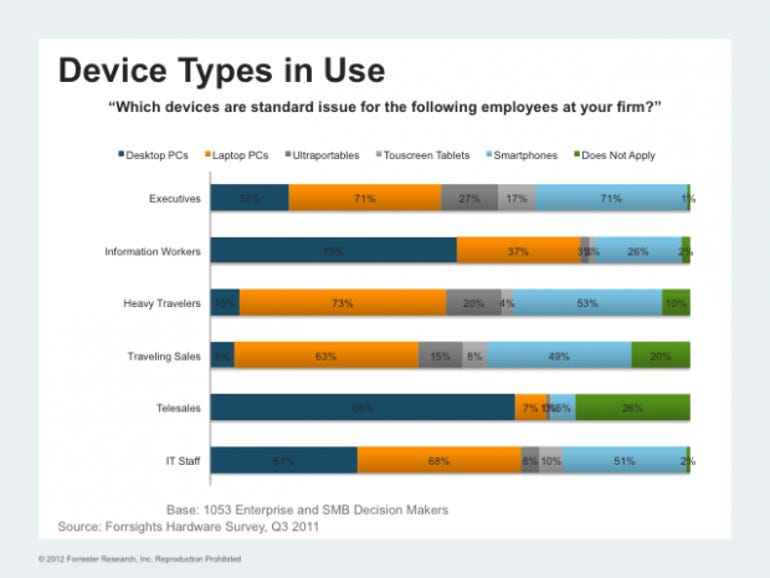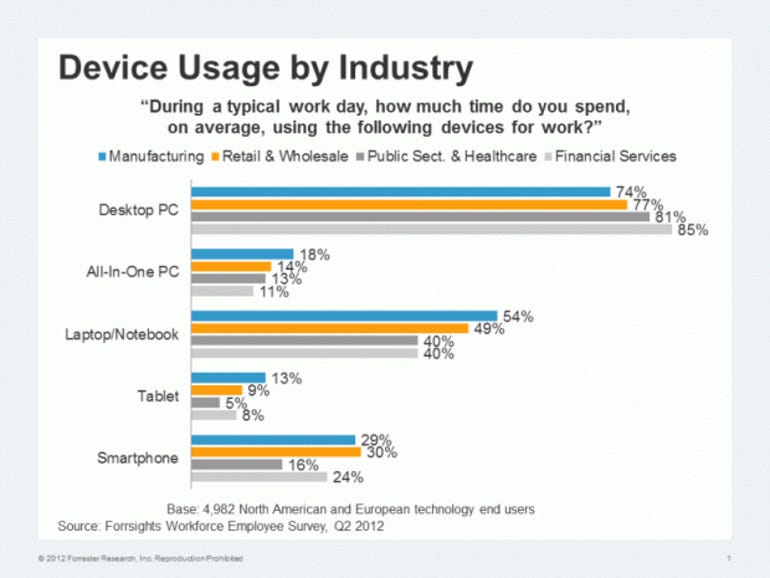Hot off the Press: What Clients are Asking About with Workforce Computing
Client questions:My answers:Trends:
- Consumerization is real, and it is not limited to tablets, smartphones and personal computers – it includes enterprise applications as well. The root causes include the relative speed at which people can either source what they need to get things done faster outside of IT, and general frustration with what their IT organization provides for both policy and personal computing hardware and applications. The data are clear on this point.
- Client virtualization continues to see increased priority and adoption but it has earned a mixed reputation. While the marketers are in full swing on Hosted Virtual Desktops like Citrix and VMware View as a mobility enabler, it's not quite that simple. Network connectivity is far from being widespread and reliable enough for productivity applications for a hosted virtual desktop to be practical for mobile workers – hybrid physical/virtual is still the reality for knowledge workers where VDI has been implemented. In other words, they will use VDI to access internal systems of record on the network but still get productive work done on their laptops directly. Local client virtualization is being used successfully in some of these cases, and can be an enabler of both bring-your-own-PC initiatives AND mobile workers. Summary: evaluate user needs carefully beforehand.
- Windows 7 adoption has hit critical mass and will be installed on 83% of new-issue corporate PCs by the end of 2012. This means that Windows 8 will be an off-cycle release for most IT organizations and will be skipped unless end users find so much value in it that they force it on IT.
- Tablets are exploding in terms of business use, but will not replace PCs for most workers. The data show that which tablet adoption is high, the people Forrester calls Laptop Power Users are carrying an average of 3.2 devices now – a notebook, smartphone or two, and a tablet. Reason: Tablets are not yet optimal for authoring content (writing documents, and creating spreadsheets or slides.
Determining the right technology mix for your workforce:
Popular now

A Few Words About TCO:
Acquisition costs:
- The average selling price for all notebook form factors in enterprise is $792 in 2011, compared with $1508 for slate tablets. The price of an iPad is relatively stable at roughly $750 for 32GB with 3G.
Software costs:
- Applications costing $200 or more are common on notebooks, including Microsoft Office, Adobe Acrobat, etc., whereas software rarely costs more than $25 on a tablet
Management Costs:
- The cost of managing a PC through its lifecycle includes deployment, application packaging, management tools, break-fix, patching, software license compliance, security tools, etc. Our survey dat show that this cost averages $1831 per employee. The largest costs are related to application packaging and deployment and operating system upgrades
- Windows XP to 7 migration costs an average of $900 per PC after application migration and repair costs, restoring end user settings, etc. – this does not include the cost of the hardware itself. Then there are the costs of the management and A/V tools at roughly $50 each, plus annual software maintenance of $10/PC. This does not include break-fix or the costs of managing the PCs through patch cycles, etc. Each of these adds tool and labor costs.
- With tablets we assume iOS or Android devices because tablets based on Windows will have the same management challenges and costs (or worse as a PC. Deployment and management tools are the largest costs (about the same as a PC), but overall the total is less because the management is simplified compared to a PC, and end users can manage all but the settings to access the company network and services on their own. Thos cost of the MDM solutions is at a premium right now ($50-$75 per device), plus software, security and management costs. Don't forget the data plan!
Device Usage By Industry:
Popular now


